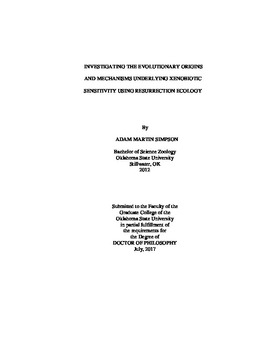| dc.contributor.advisor | Belden, Jason B. | |
| dc.contributor.author | Simpson, Adam Martin | |
| dc.date.accessioned | 2018-04-23T19:36:20Z | |
| dc.date.available | 2018-04-23T19:36:20Z | |
| dc.date.issued | 2017-07 | |
| dc.identifier.uri | https://hdl.handle.net/11244/299550 | |
| dc.description.abstract | Sensitivity to an organophosphate insecticide, chlorpyrifos, was evaluated in a resurrected population of Daphnia pulicaria; this population originated from a lake that has experienced over a century of cultural eutrophication. Acute toxicity tests demonstrated that ancient clones (1301-1646 A.D.) were 2.7x more sensitive to this chemical when compared to the contemporary clones (1967-1977, 2002-2008 A.D.). Such changes might have arisen from historical exposure to chlorpyrifos, other organic contaminants, or by selection driven by stressors associated with cultural eutrophication. | |
| dc.description.abstract | To determine the physiological mechanisms of tolerance, a series of biochemical assays was performed on the three most tolerant and three most sensitive genotypes from the population, resurrected from 1967-1977 and 1301-1646 A.D., respectively. In vitro acetylcholinesterase assays were conducted to examine the potential for target-site tolerance, but yielded no significant differences in constitutive enzyme activity or sensitivity to inhibition. To evaluate the potential for metabolic tolerance, acute toxicity tests were conducted using I) the toxic metabolite chlorpyrifos-oxon (CPF-O) and ii) CPF-O co-applied with piperonyl butoxide (PBO), a known inhibitor of Phase-I biotransformation. Both series of toxicity tests reduced the mean variation in sensitivity between tolerant and sensitive genotypes. Most significantly, exposure to CPF-O and PBO reduced the disparity between the clones from a 4.7-fold to 1.2-fold difference in sensitivity. This strongly suggested that pathways involving Phase-I detoxification and/or bioactivation of chlorpyrifos play a significant role in dictating tolerance in this population. | |
| dc.description.abstract | An in vivo assay was developed to quantify biotransformation of metabolic substrates in invertebrates via gas chromatography/mass spectroscopy. The assay was highly successful for Physa snails, but was unable to detect activity in response to most substrates in Daphnia magna. The assay shows promise, but further optimization is needed to effectively evaluate xenobiotic metabolism in Daphnia. | |
| dc.description.abstract | Finally, the evolutionary origins of shifts in xenobiotic sensitivity are discussed. The role of metabolism in dictating sensitivity to natural and anthropogenic stressors suggests that adaptive shifts in response to one stressor might indirectly influence susceptibility to others. This phenomenon could have important implications for the success of wild populations facing rapid environmental change. | |
| dc.format | application/pdf | |
| dc.language | en_US | |
| dc.rights | Copyright is held by the author who has granted the Oklahoma State University Library the non-exclusive right to share this material in its institutional repository. Contact Digital Library Services at lib-dls@okstate.edu or 405-744-9161 for the permission policy on the use, reproduction or distribution of this material. | |
| dc.title | Investigating the evolutionary origins and mechanisms underlying xenobiotic sensitivity using resurrection ecology | |
| dc.contributor.committeeMember | Campbell, Polly | |
| dc.contributor.committeeMember | Steets, Janette Ann | |
| dc.contributor.committeeMember | Jeyasingh, Punidan D. | |
| osu.filename | Simpson_okstate_0664D_15343.pdf | |
| osu.accesstype | Open Access | |
| dc.type.genre | Dissertation | |
| dc.type.material | Text | |
| thesis.degree.discipline | Integrative Biology | |
| thesis.degree.grantor | Oklahoma State University | |
